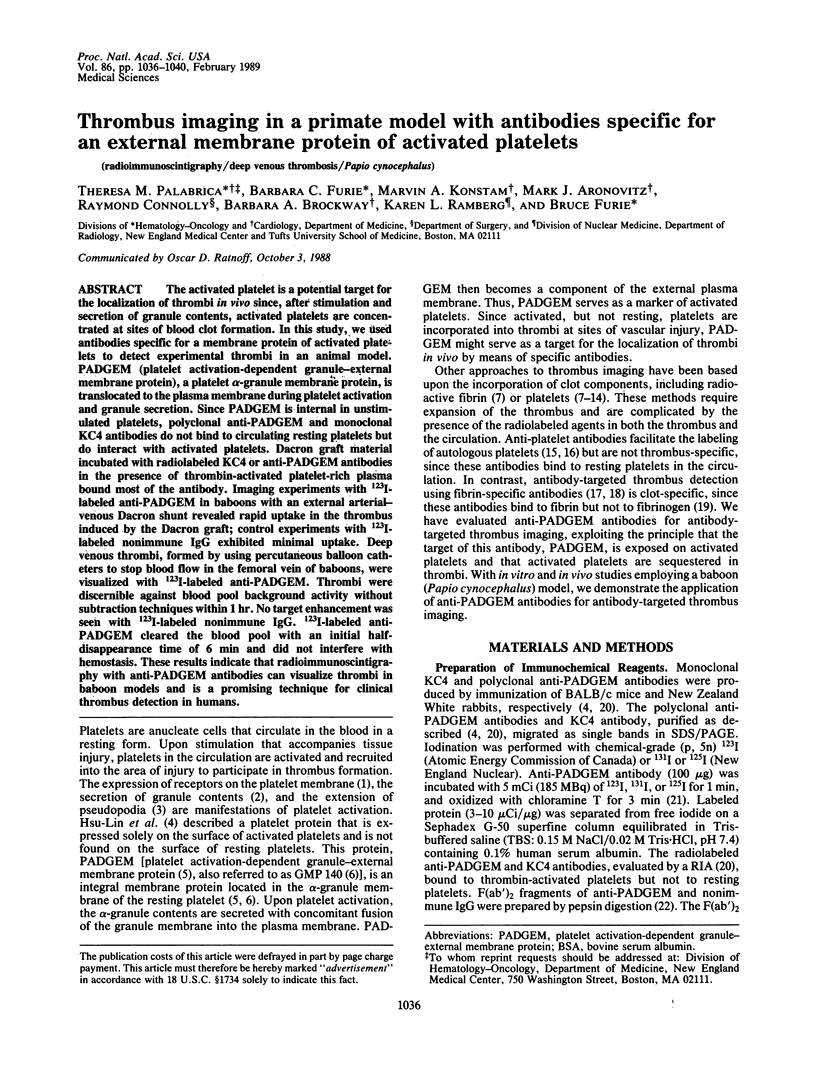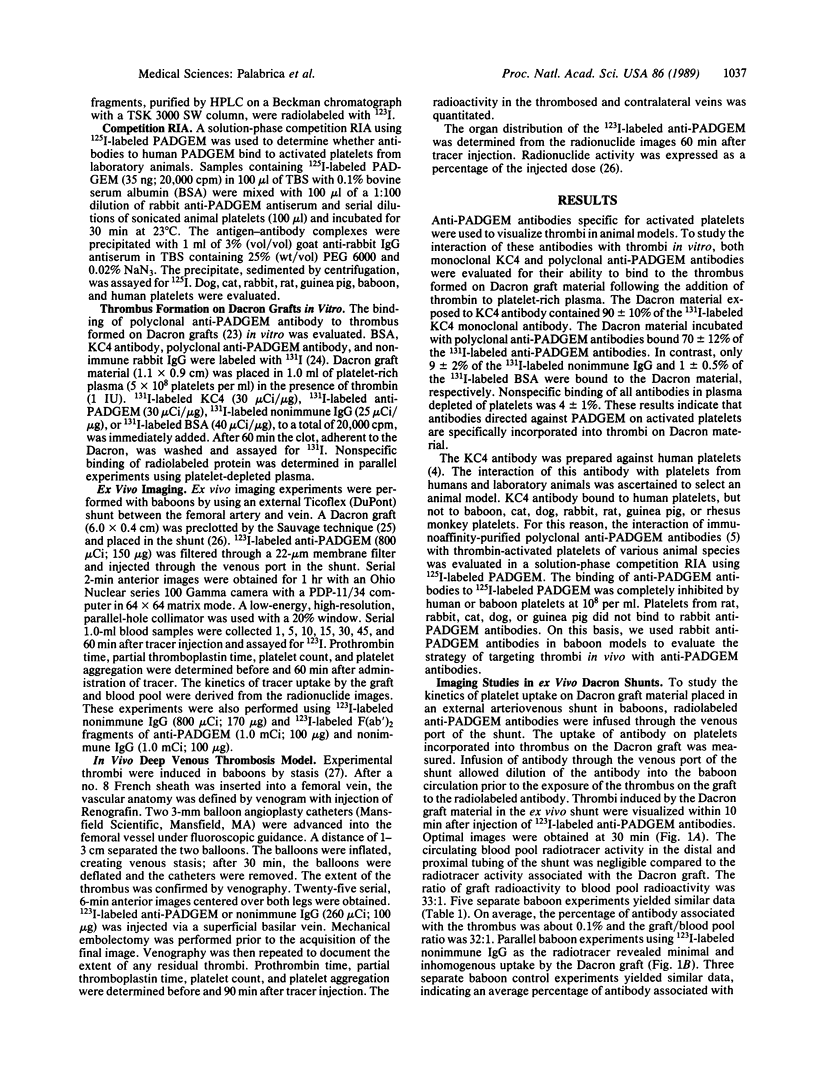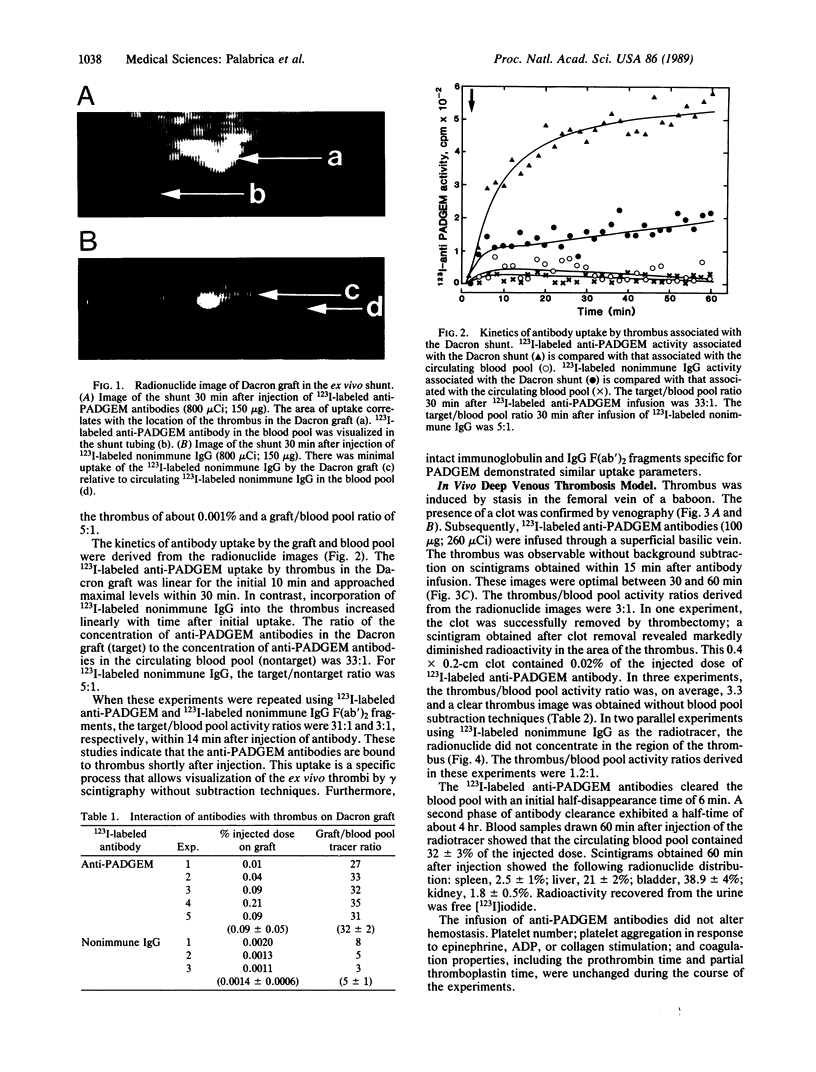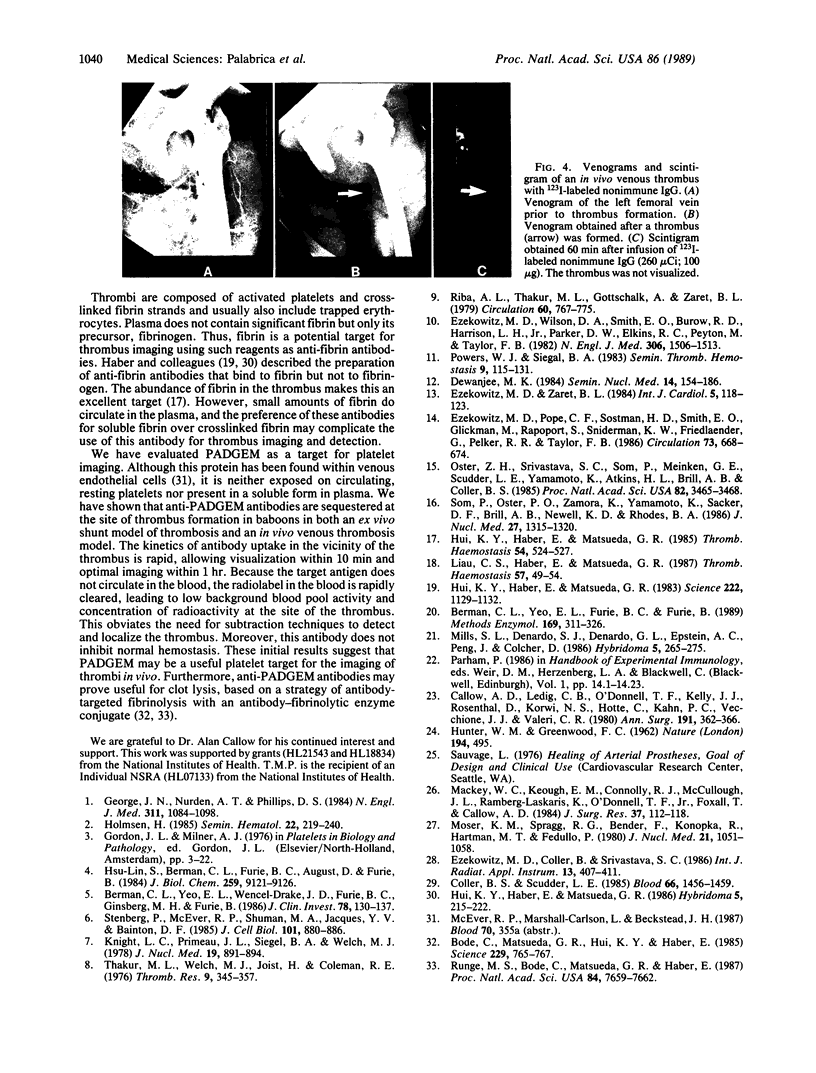Abstract
The activated platelet is a potential target for the localization of thrombi in vivo since, after stimulation and secretion of granule contents, activated platelets are concentrated at sites of blood clot formation. In this study, we used antibodies specific for a membrane protein of activated platelets to detect experimental thrombi in an animal model. PADGEM (platelet activation-dependent granule-external membrane protein), a platelet alpha-granule membrane protein, is translocated to the plasma membrane during platelet activation and granule secretion. Since PADGEM is internal in unstimulated platelets, polyclonal anti-PADGEM and monoclonal KC4 antibodies do not bind to circulating resting platelets but do interact with activated platelets. Dacron graft material incubated with radiolabeled KC4 or anti-PADGEM antibodies in the presence of thrombin-activated platelet-rich plasma bound most of the antibody. Imaging experiments with 123I-labeled anti-PADGEM in baboons with an external arterial-venous Dacron shunt revealed rapid uptake in the thrombus induced by the Dacron graft; control experiments with 123I-labeled nonimmune IgG exhibited minimal uptake. Deep venous thrombi, formed by using percutaneous balloon catheters to stop blood flow in the femoral vein of baboons, were visualized with 123I-labeled anti-PADGEM. Thrombi were discernible against blood pool background activity without subtraction techniques within 1 hr. No target enhancement was seen with 123I-labeled nonimmune IgG. 123I-labeled anti-PADGEM cleared the blood pool with an initial half-disappearance time of 6 min and did not interfere with hemostasis. These results indicate that radioimmunoscintigraphy with anti-PADGEM antibodies can visualize thrombi in baboon models and is a promising technique for clinical thrombus detection in humans.
Full text
PDF




Images in this article
Selected References
These references are in PubMed. This may not be the complete list of references from this article.
- Berman C. L., Yeo E. L., Furie B. C., Furie B. PADGEM protein. Methods Enzymol. 1989;169:311–326. doi: 10.1016/0076-6879(89)69071-4. [DOI] [PubMed] [Google Scholar]
- Berman C. L., Yeo E. L., Wencel-Drake J. D., Furie B. C., Ginsberg M. H., Furie B. A platelet alpha granule membrane protein that is associated with the plasma membrane after activation. Characterization and subcellular localization of platelet activation-dependent granule-external membrane protein. J Clin Invest. 1986 Jul;78(1):130–137. doi: 10.1172/JCI112542. [DOI] [PMC free article] [PubMed] [Google Scholar]
- Bode C., Matsueda G. R., Hui K. Y., Haber E. Antibody-directed urokinase: a specific fibrinolytic agent. Science. 1985 Aug 23;229(4715):765–767. doi: 10.1126/science.4023710. [DOI] [PubMed] [Google Scholar]
- Callow A. D., Ledig C. B., O'Donnell T. F., Kelly J. J., Rosenthal D., Korwin S., Hotte C., Kahn P. C., Vecchione J. J., Valeri C. R. A primate model for the study of the interaction of 111In-labeled baboon platelets with Dacron arterial prostheses. Ann Surg. 1980 Mar;191(3):362–366. doi: 10.1097/00000658-198003000-00017. [DOI] [PMC free article] [PubMed] [Google Scholar]
- Coller B. S., Scudder L. E. Inhibition of dog platelet function by in vivo infusion of F(ab')2 fragments of a monoclonal antibody to the platelet glycoprotein IIb/IIIa receptor. Blood. 1985 Dec;66(6):1456–1459. [PubMed] [Google Scholar]
- Dewanjee M. K. Cardiac and vascular imaging with labeled platelets and leukocytes. Semin Nucl Med. 1984 Jul;14(3):154–187. doi: 10.1016/s0001-2998(84)80013-6. [DOI] [PubMed] [Google Scholar]
- Ezekowitz M. D., Coller B. S., Srivastava S. C. Potential application of labeled antibodies for thrombus detection. Int J Rad Appl Instrum B. 1986;13(4):407–411. doi: 10.1016/0883-2897(86)90018-8. [DOI] [PubMed] [Google Scholar]
- Ezekowitz M. D., Pope C. F., Sostman H. D., Smith E. O., Glickman M., Rapoport S., Sniderman K. W., Friedlaender G., Pelker R. R., Taylor F. B. Indium-111 platelet scintigraphy for the diagnosis of acute venous thrombosis. Circulation. 1986 Apr;73(4):668–674. doi: 10.1161/01.cir.73.4.668. [DOI] [PubMed] [Google Scholar]
- Ezekowitz M. D., Wilson D. A., Smith E. O., Burow R. D., Harrison L. H., Jr, Parker D. E., Elkins R. C., Peyton M., Taylor F. B. Comparison of Indium-111 platelet scintigraphy and two-dimensional echocardiography in the diagnosis of left ventricular thrombi. N Engl J Med. 1982 Jun 24;306(25):1509–1513. doi: 10.1056/NEJM198206243062502. [DOI] [PubMed] [Google Scholar]
- Ezekowitz M. D., Zaret B. L. Indium-111 platelet scintigraphy, a technique whose time has come. Int J Cardiol. 1984 Jan;5(1):118–123. doi: 10.1016/0167-5273(84)90071-8. [DOI] [PubMed] [Google Scholar]
- George J. N., Nurden A. T., Phillips D. R. Molecular defects in interactions of platelets with the vessel wall. N Engl J Med. 1984 Oct 25;311(17):1084–1098. doi: 10.1056/NEJM198410253111705. [DOI] [PubMed] [Google Scholar]
- HUNTER W. M., GREENWOOD F. C. Preparation of iodine-131 labelled human growth hormone of high specific activity. Nature. 1962 May 5;194:495–496. doi: 10.1038/194495a0. [DOI] [PubMed] [Google Scholar]
- Holmsen H. Platelet metabolism and activation. Semin Hematol. 1985 Jul;22(3):219–240. [PubMed] [Google Scholar]
- Hsu-Lin S., Berman C. L., Furie B. C., August D., Furie B. A platelet membrane protein expressed during platelet activation and secretion. Studies using a monoclonal antibody specific for thrombin-activated platelets. J Biol Chem. 1984 Jul 25;259(14):9121–9126. [PubMed] [Google Scholar]
- Hui K. Y., Haber E., Matsueda G. R. Immunodetection of human fibrin using monoclonal antibody-64C5 in an extracorporeal chicken model. Thromb Haemost. 1985 Aug 30;54(2):524–527. [PubMed] [Google Scholar]
- Hui K. Y., Haber E., Matsueda G. R. Monoclonal antibodies of predetermined specificity for fibrin: a rational approach to monoclonal antibody production. Hybridoma. 1986 Fall;5(3):215–222. doi: 10.1089/hyb.1986.5.215. [DOI] [PubMed] [Google Scholar]
- Hui K. Y., Haber E., Matsueda G. R. Monoclonal antibodies to a synthetic fibrin-like peptide bind to human fibrin but not fibrinogen. Science. 1983 Dec 9;222(4628):1129–1132. doi: 10.1126/science.6648524. [DOI] [PubMed] [Google Scholar]
- Knight L. C., Primeau J. L., Siegel B. A., Welch M. J. Comparison of In-111-labeled platelets and iodinated fibrinogen for the detection of deep vein thrombosis. J Nucl Med. 1978 Aug;19(8):891–894. [PubMed] [Google Scholar]
- Liau C. S., Haber E., Matsueda G. R. Evaluation of monoclonal antifibrin antibodies by their binding to human blood clots. Thromb Haemost. 1987 Feb 3;57(1):49–54. [PubMed] [Google Scholar]
- Mackey W. C., Keough E. M., Connolly R. J., McCullough J. L., Ramberg-Laskaris K., O'Donnell T. F., Jr, Foxall T., Callow A. D. A baboon flow-regulated shunt for the study of small caliber vascular grafts. J Surg Res. 1984 Aug;37(2):112–118. doi: 10.1016/0022-4804(84)90170-7. [DOI] [PubMed] [Google Scholar]
- Mills S. L., Denardo S. J., Denardo G. L., Epstein A. L., Peng J. S., Colcher D. 123I radiolabeling of monoclonal antibodies for in vivo procedures. Hybridoma. 1986 Winter;5(4):265–275. doi: 10.1089/hyb.1986.5.265. [DOI] [PubMed] [Google Scholar]
- Moser K. M., Spragg R. G., Bender F., Konopka R., Hartman M. T., Fedullo P. Study of factors that may condition scintigraphic detection of venous thrombi and pulmonary emboli with indium-111-labeled platelets. J Nucl Med. 1980 Nov;21(11):1051–1058. [PubMed] [Google Scholar]
- Oster Z. H., Srivastava S. C., Som P., Meinken G. E., Scudder L. E., Yamamoto K., Atkins H. L., Brill A. B., Coller B. S. Thrombus radioimmunoscintigraphy: an approach using monoclonal antiplatelet antibody. Proc Natl Acad Sci U S A. 1985 May;82(10):3465–3468. doi: 10.1073/pnas.82.10.3465. [DOI] [PMC free article] [PubMed] [Google Scholar]
- Powers W. J., Siegel B. A. Thrombus imaging with indium-111 platelets. Semin Thromb Hemost. 1983 Apr;9(2):115–131. doi: 10.1055/s-2007-1005017. [DOI] [PubMed] [Google Scholar]
- Riba A. L., Thakur M. L., Gottschalk A., Zaret B. L. Imaging experimental coronary artery thrombosis with indium-111 platelets. Circulation. 1979 Oct;60(4):767–775. doi: 10.1161/01.cir.60.4.767. [DOI] [PubMed] [Google Scholar]
- Runge M. S., Bode C., Matsueda G. R., Haber E. Antibody-enhanced thrombolysis: targeting of tissue plasminogen activator in vivo. Proc Natl Acad Sci U S A. 1987 Nov;84(21):7659–7662. doi: 10.1073/pnas.84.21.7659. [DOI] [PMC free article] [PubMed] [Google Scholar]
- Som P., Oster Z. H., Zamora P. O., Yamamoto K., Sacker D. F., Brill A. B., Newell K. D., Rhodes B. A. Radioimmunoimaging of experimental thrombi in dogs using technetium-99m-labeled monoclonal antibody fragments reactive with human platelets. J Nucl Med. 1986 Aug;27(8):1315–1320. [PubMed] [Google Scholar]
- Stenberg P. E., McEver R. P., Shuman M. A., Jacques Y. V., Bainton D. F. A platelet alpha-granule membrane protein (GMP-140) is expressed on the plasma membrane after activation. J Cell Biol. 1985 Sep;101(3):880–886. doi: 10.1083/jcb.101.3.880. [DOI] [PMC free article] [PubMed] [Google Scholar]
- Thakur M. L., Welch M. J., Joist J. H., Coleman R. E. Indium-LLL labeled platelets: studies on preparation and evaluation of in vitro and in vivo functions. Thromb Res. 1976 Oct;9(4):345–357. doi: 10.1016/0049-3848(76)90135-3. [DOI] [PubMed] [Google Scholar]






